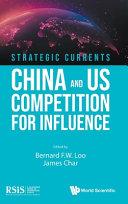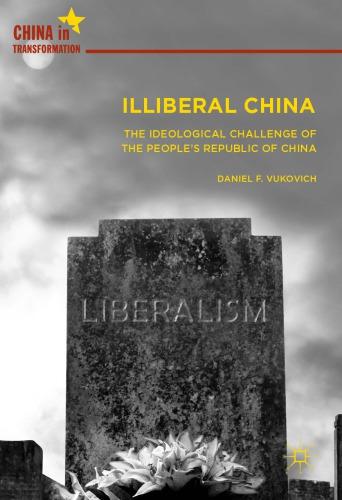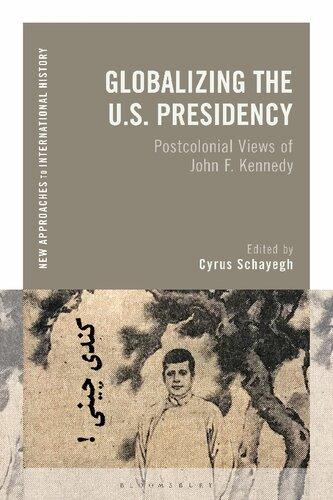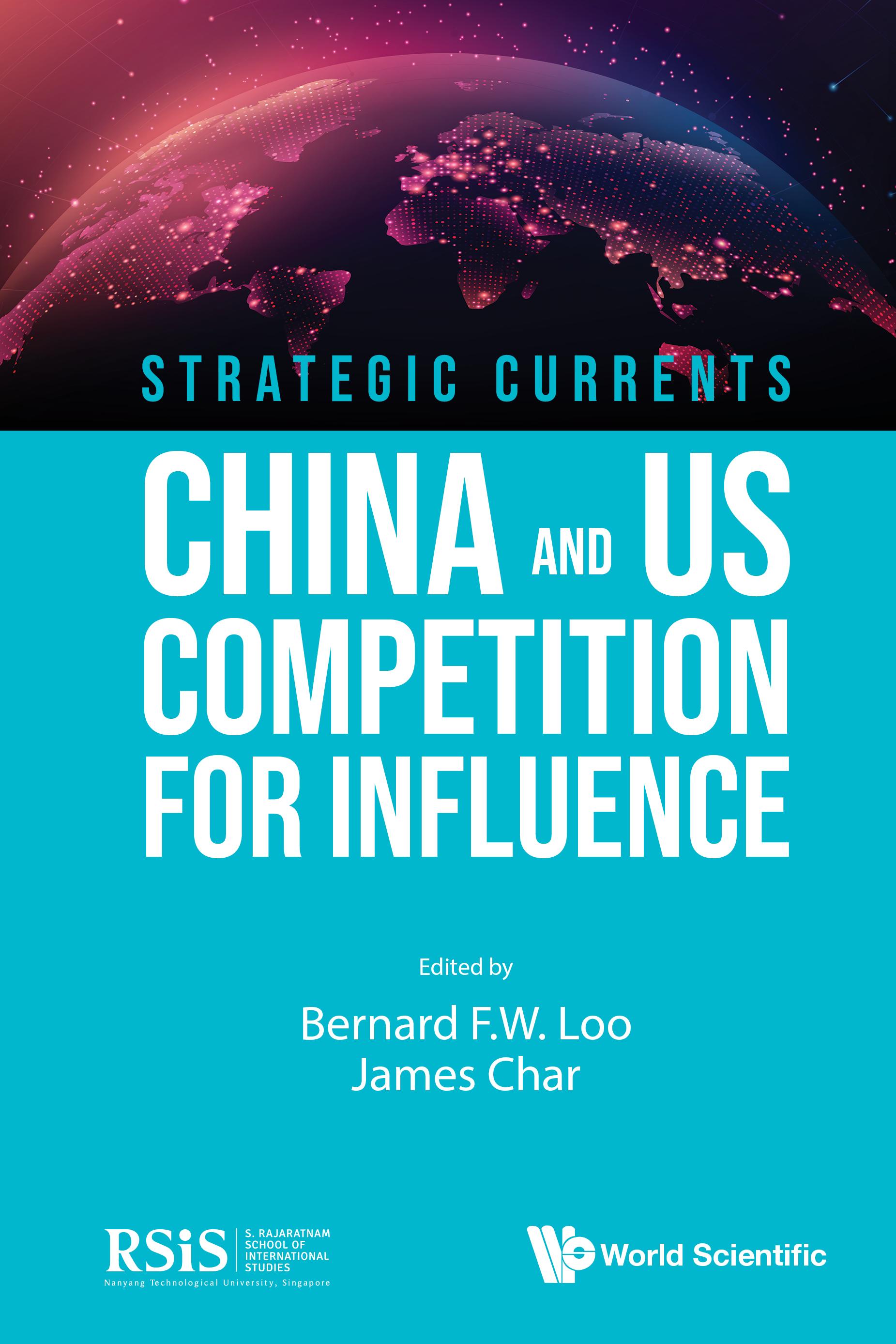Strategic Currents
Print ISSN: 3029-1836
Online ISSN: 3029-1828
Series Editors:
Bernard F.W. Loo
S. Rajaratnam School of International Studies
Nanyang Technological University, Singapore
James Char
S. Rajaratnam School of International Studies
Nanyang Technological University, Singapore
Strategic Currents is an annual publication by the S. Rajaratnam School of International Studies. Each issue will be a collection of original essays by prominent scholars in the field of international security, centred on an issue or theme of emerging significance for regional and international security.
Published by World Scientific Publishing Co. Pte. Ltd.:
Strategic Currents: China and US Competition for Influence
edited by Bernard F.W. Loo and James Char
Published by S. Rajaratnam School of International Studies, Nanyang Technological University and Institute of Southeast Asian Studies, National University of Singapore:
Strategic Currents: Issues in Human Security in Asia
edited by Yang Razali Kassim
Strategic Currents: Emerging Trends in Southeast Asia
edited by Yang Razali Kassim
Published by S. Rajaratnam School of International Studies, Nanyang Technological University:
Strategic Currents: Marking the Transition to the S. Rajaratnam School of International Studies
edited by Yang Razali Kassim
Published by
World Scientific Publishing Co. Pte. Ltd.
5 Toh Tuck Link, Singapore 596224
USA office: 27 Warren Street, Suite 401-402, Hackensack, NJ 07601
UK office: 57 Shelton Street, Covent Garden, London WC2H 9HE
National Library Board, Singapore Cataloguing in Publication Data
Name(s): Loo, Bernard Fook Weng, editor. | Char, James, editor.
Title: China and US competition for influence / edited by Bernard F.W. Loo, James Char.
Other Title(s): Strategic currents.
Description: Singapore : World Scientific Publishing Co. Pte. Ltd., [2024]
Identifier(s): ISBN 978-981-12-8807-4 (hardcover) | ISBN 978-981-12-8843-2 (paperback) | ISBN 978-981-12-8808-1 (ebook for institutions) | ISBN 978-981-12-8809-8 (ebook for individuals)
Subject(s): LCSH: Great powers--Foreign relations. | United States--Foreign relations-China--21st century. | United States--Foreign relations--Southeast Asia--21st century. | China--Foreign relations--United States--21st century. | China--Foreign relations-Southeast Asia--21st century. | Southeast Asia--Foreign relations--United States--21st century. | Southeast Asia--Foreign relations--China--21st century.
Classification: DDC 327.51073--dc23
British Library Cataloguing-in-Publication Data
Acatalogue record for this book is available from the British Library.
Strategic Currents
STRATEGIC CURRENTS
China and US Competition for Inf uence
Copyright © 2024 by S. Rajaratnam School of International Studies
All rights reserved.
ISBN 978-981-12-8807-4 (hardcover)
ISBN 978-981-12-8843-2 (paperback)
ISBN 978-981-12-8808-1 (ebook for institutions)
ISBN 978-981-12-8809-8 (ebook for individuals)
For any available supplementary material, please visit https://www.worldscientific.com/worldscibooks/10.1142/13726#t=suppl
Desk Editor: Kura Sunaina
Typeset by Stallion Press
Email: enquiries@stallionpress.com
Printed in Singapore
© 2024 S. Rajaratnam School of International Studies
https://doi.org/10.1142/9789811288081_fmatter
About the Editors

Bernard F. W. Loo is a Senior Fellow with the Military Studies Programme, and concurrently Coordinator of the Master of Science (Strategic Studies) Programme at the S. Rajaratnam School of International Studies (RSIS) at Nanyang Technological university (NTU), Singapore. He completed his doctoral studies at the Department of International Politics at the University of Wales, Aberystwyth in 2002. He is the author of Medium Powers and Accidental Wars: A Study in Conventional Strategic Stability (Edwin Mellen, 2005). His edited volume, Military Transformation and Operations (Routledge, 2009) was translated into complex Chinese for the Taiwanese military. His other publications have appeared in the Journal of Strategic Studies, Contemporary Southeast Asia, NIDS Security Reports, and Taiwan Defense Affairs. He is a regular commentator on defense matters, and his commentaries have appeared in The Straits Times (Singapore), The Nation (Thailand), and The New Straits Times (Malaysia).

James Char is a Research Fellow with the China Programme at the S. Rajaratnam School of International Studies (RSIS) at Nanyang Technological University (NTU), Singapore. He is a specialist in Chinese domestic politics, civilmilitary relations in China, China’s diplomatic strategies in the global south as well as the history of the Chinese Civil War. In addition to being a regular commentator on China’s national and international politics in international media outlets, he has served as guest editor with top-tier peer-reviewed journals including The China Quarterly , Journal of Strategic Studies, and Asian Security. He is the editor of Modernizing the People’s Liberation Army: Aspiring to be a Global Military Power (forthcoming, May 2024).
© 2024 S. Rajaratnam School of International Studies
https://doi.org/10.1142/9789811288081_fmatter
Introduction: Technology Competition Between China and the United States: Problems, Prospects, and Challenges
Bernard F. W. Loo and James Char
The growing contestations between the People’s Republic of China (PRC, henceforth China) and the United States of America (henceforth the US) now span a range of dimensions, including the more traditional military, diplomatic, economic, and soft power realms. That the US–China relationship has now become the single most consequential Great Power competition confronting international politics in the 21st century is not in doubt. In view of what appears to be an emerging power transition between the global hegemon and the Asian giant, this Great Power dynamic has been characterised by American scholar Graham Allison as a potential Thucydides Trap.1 Adding to this debate, other scholars have called
1 Graham Allison, Destined for War: Can America and China Avoid the Thucydides Trap? (Houghton Mifflin Harcourt, 2017).
B.F.W. Loo & J. Char
this US–China relationship a new Cold War,2 although some continue to resist such labels.3 Much, nevertheless, has been speculated about the possibility of a military conflict between China and the US, as a consequence. The Great Power dynamic of the 20th century mostly took on the unidimensional character of the Cold War between the former Soviet Union and the US, which had its diplomatic dimensions but was manifested to a large extent in a thermonuclear arms race. As it was, the Soviet Union’s inability to compete with the US — both technologically and economically — led Australian scholar Paul Dibb to famously classify the Soviet Union as an “incomplete superpower”.4 In stark contrast to the late 20th century’s Cold War adversaries, the current Great Power contest between China and the US is multifaceted, and both states are competing as peers, or at least near-peers, across a range of domains. Crucially, unlike the situation in the Cold War, Beijing and Washington are conjoined economically, with the trade and monetary exchanges between them involving a myriad of manufacturing industries and their consumer markets.
2 See, for instance: Hal Brands and John Lewis Gaddis, “The new cold war: America, China, and the echoes of history”, Foreign Affairs 100 (2021): 10–21; Avery Goldstein, “US-China Rivalry in the 21st Century: Déjà vu and Cold War II”, China International Strategy Review 2 (2020): 48–62; Michael McFaul, “Cold War Lessons and Fallacies for US-China Relations Today”, Washington Quarterly 43, no. 4 (2022): 7–39; Seth Schindler, Jessica DiCarlo and Dinesh Paudel, “The new cold war and the rise of the 21st-century infrastructure state”, Transactions of the Institute of British Geographers 47, no. 2 (2022): 331–346; Yang Yao, “The New Cold War: America’s new approach to Sino-American relations”, China International Strategy Review 3 (2021): 20–33.
3 See, for instance: Li Xing and Raul Bernal-Meza, “China-US rivalry: A new cold war or capitalism’s intra-core competition?” Revista Brasileira de Política Internacional 64 (2021): 1–20, doi.org/10.1590/0034-7329202100110; Minghao Zhao, “Is a new cold war inevitable? Chinese perspectives on US–China strategic competition”, Chinese Journal of International Politics 12, no. 3 (2019): 371–394, doi.org/10.1093/cjip/poz010.
4 Paul Dibb, The Soviet Union: The Incomplete Superpower (University of Illinois Press, 1986).
Introduction
In the military arena, this growing competition is best manifested in both Great Powers’ respective defence budgets. 5 In 1990, China’s defence budget (US$23 billion) consumed 2.5% of the country’s gross domestic product (GDP), whereas the US defence budget (US$674 billion) took up 5.6% of the US GDP. By 2021, China’s defence budget (US$297 billion) was reported to be 1.7% of its GDP, while the US defence budget (US$811 billion) was 3.6% of the American GDP. But, these figures alone do not convey the entire military picture, since the Chinese People’s Liberation Army (PLA) has similarly expanded significantly in that same period: from a military “widely dismissed as a ‘junkyard army’… saddled with outdated equipment [and] also hamstrung by problems with personnel quality, poor training, and the distractions and massive corruption” 6 to one that is “clearly becoming an increasingly professional and capable fighting force”. 7
In 2020, the Chinese naval fleet comprised 4 ballistic missile submarines, 7 nuclear-powered attack submarines, and 43 principal surface combatants (aircraft carriers, cruisers, and destroyers). By 2030, China’s fleet will grow further to 8 ballistic missile submarines, 13 nuclear-powered attack submarines, and 65 principal surface combatants (of which 5 are likely to be aircraft carriers). Even if some doubts continue to linger regarding the combat quality of its aircraft
5 All data for Chinese and US defence spending come from the Stockholm International Peace Research Institute (SIPRI) Military Expenditure Database, https://milex.sipri.org/ sipri. Figures are expressed in constant 2021 US dollars.
6 Michael S. Chase et al. , China’s Incomplete Military Transformation: Assessing the Weaknesses of the People’s Liberation Army (PLA) (Santa Monica, CA: RAND Corporation, 2015), p. 14.
7 Ibid., p. 16.
B.F.W. Loo & J. Char
carriers, 8 the Chinese military today ought to be recognised as an increasingly sophisticated armed force. At the same time, the PLA has been modernising its intercontinental ballistic missiles, of which the solid-fuelled Dongfeng (DF)-41 has an estimated circular error probability (that is, its accuracy) of 100 metres, representing a significant improvement on older Chinese ballistic missiles.9 One study suggested that as early as 2017, the Chinese may already have gained the upper hand against the US in specific wartime scenarios, such as attacks on US air bases and the suppression of American surface combatants.10
The competition between these two Great Powers also takes place in the diplomatic realm. In that regard, and to borrow a phrase from the popular book, How to Win Friends and Influence People, China has made some gains in this sphere as part of its contestations to challenge the US-led global order. Indeed, the international influence Beijing now wields following four decades of economic liberalisation — without having to succumb to western pressures to politically reform — continues to hold allure for developing nations around the world. By offering a model that is both non-western and non-democratic for others still in the throes of development, China has been working to
8 John Grady, “China’s Navy could have 5 aircraft carriers, 10 Ballistic Missile Subs by 2030 says CSBA Report”, USNI News, 18 August 2022, https://news.usni.org/2022/08/18/ chinas-navy-could-have-5-aircraft-carriers-10-ballistic-missile-subs-by-2030-says-csbareport. On doubts regarding the quality of China’s carriers, see, for instance: Greg Torode, Eduardo Baptista and Tim Kelly, “China’s aircraft carriers play ‘theatrical’ role but pose little threat yet”, Reuters, 5 May 2023, www.reuters.com/world/chinas-aircraftcarriers-play-theatrical-role-pose-little-threat-yet-2023-05-05/.
9 Fiona S. Cunningham, “The unknowns about China’s nuclear modernization”, Arms Control Association, June 2023, www.armscontrol.org/act/2023-06/features/unknownsabout-chinas-nuclear-modernization-program.
10 RAND Corporation, Tallying the US-China Military Scorecard: Relative Capability and Balance of Power, 1996–2017, RR-392-AF (Santa Monica, CA: RAND Corporation, 2015), pp. 1–4.
subvert the extant US-led order via a policy bestriding liberalist and constructivist platforms for realist ends. As part of its efforts to vie for global leadership, China’s engagement with countries in the global south in particular has become more prominent in the wake of the COVID-19 pandemic as well as Russia’s invasion of Ukraine. As a means of balancing against Washington’s global preponderance, China’s selfidentification with other emerging economies, in addition to its drawing of institutional support from the global south, has recently been reinvigorated after the pandemic-induced hiatus as Beijing continues to translate its economic clout into a stronger political, diplomatic, and military presence globally.
Now a decade since its announcement in 2013, the Belt and Road Initiative (BRI) is the centrepiece of President Xi Jinping’s diplomatic strategy, consisting of the “Silk Road Economic Belt” (an overland network of road and rail from China to Europe) and the “21st Century Maritime Silk Road” (comprising the sea routes through the IndoPacific via Southeast Asia, South Asia, and towards Africa and the Middle East).11 Although some of its signatories have derived tangible economic benefits, this Chinese project has met with setbacks in other cases given how Beijing has had to spend equally vast sums of money to bail out countries struggling with their BRI debts 12 — not to mention the previous breakdown in global trade amidst the earliest phase of the pandemic. Additionally, the initiative continues to be plagued by reservations over the transparency and sustainability of its commodity-backed debt financing, inviting accusations that Beijing has strategically been exploiting host countries by saddling them with
11 For a concise background, see Daniel Yergin, The New Map: Energy, Climate, and the Clash of Nations (Penguin Press, 2020), pp. 170–181.
12 Amy Hawkins, “China woos global south and embraces Putin at belt and road Beijing summit”, The Guardian, 16 October 2023.
B.F.W. Loo & J. Char
“debt traps”.13 The BRI has been condemned even by some foreign communities supposedly served by Chinese investments, as can be seen in the example of terrorist attacks on Chinese nationals in the restive Balochistan region of Pakistan. 14 Most damagingly perhaps, the emergence of COVID-19 put a dent on the BRI as many related infrastructure projects were placed on hold, with as much as 20% of its programmes “seriously affected” in mid-2020. 15 Thus, even if Chinese officialdom recently touted BRI’s contributions to “global connectivity, peace and prosperity”, 16 its actual effect in boosting global development remains up for debate. Of late, the announcement of a new Global Development Initiative (GDI) in September 2021 also means the BRI could yet become subsumed under this more expansive framework.
Given the heftier economic resources at President Xi’s disposal than at any other time in the PRC’s history, China’s international behaviour has similarly undergone major change. Even as the earlier “Wolf Warrior” diplomacy appears to have been abandoned for now, an emergent reorientation in China’s approach to international relations — from “development” to “security” — has become apparent, with Chinese officials now touting their leader’s Global Security Initiative
13 Deborah Brautigam and Meg Rithmire, “The Chinese “debt trap” is a Myth”, The Atlantic, 6 February 2021, www.theatlantic.com/international/archive/2021/02/chinadebt-trap-diplomacy/617953/.
14 Maham Hameed, “The politics of the China–Pakistan economic corridor”, Palgrave Communications 4, no. 64 (2018): 1–10; and Adnan Aamir, “China wants own security company to protect assets in Pakistan”, Nikkei Asia, 28 June 2022, https://asia.nikkei. com/Politics/International-relations/China-wants-own-security-company-to-protectassets-in-Pakistan.
15 Rene Zou, “Assessing the impact of Covid-19 on the belt and road initiative”, Hong Kong Trade Development Council (HKTDC), 28 September 2020.
16 Li Xuanmin and Qi Xijia, “BRI turns vision into action: White paper”, Global Times, 10 October 2023.
Introduction (GSI) and the nebulous concept of “indivisible security” as an alternative to the US-led order. Running in parallel to the GDI and the Global Civilization Initiative (GCI), the new security concept incorporates the right to safeguard one’s legitimate security interests, i.e., that no country’s security should be built at the expense of others’ security. Accordingly, Beijing could potentially seize the moral high ground should it decide to retaliate against US military activities that run counter to Chinese interests.
In light of the circumspection with which China eyes the world’s top-ranked power, however, the effects of the GSI on actual Chinese policy have so far been mostly rhetorical. Just as Moscow has blamed the West and attributed the war in Ukraine to the expansion of the North Atlantic Treaty Organization (NATO), Beijing can be expected to continue agitating for the developing world to oppose so-called “US-led blocs” as it persists with accusing Washington of fomenting global conflicts and tensions.17 Not unimportantly, it remains unclear whether the idea will receive the same level of institutional support domestically or be as well received outside China as the economically focused BRI. Especially on the latter, the reputational cost resultant from Beijing’s association with Moscow in the aftermath of Russia’s 2022 invasion of Ukraine may have already compromised the appeal of the GSI.18
As Beijing pursues the securitisation of its growing interests abroad while safeguarding its domestic socio-economic stability, it has maintained its efforts to garner multilateral, institutional support from the developing world to balance against the US. As a response to what
17 Kathrin Hille, “China builds coalition to counter America’s ‘Barbaric and Bloody’ leadership”, Financial Times, 27 May 2020.
18 Reuters, “U.S. says China continues to ‘parrot’ some Russian security concepts”, Reuters, 22 April 2022.
B.F.W. Loo & J. Char
the Chinese Communist Party (CCP) leadership perceives as Washington’s containment policies, the party’s armed wing, the PLA, has been playing a more visible role as a foreign policy instrument in Beijing’s struggle for global hegemony. Concomitantly, as countries that had already signed up to China’s ambitious infrastructure and investment plans resume their engagements after the COVID-19 pandemic, a number of strategically located developing countries have become the new focal point of Chinese affection as part of the PLA’s putative “Project 141” initiative, which seeks to establish 5 overseas bases and 10 logistics support facilities by the year 2030.19 Perhaps unsurprisingly, China has been observed to be focusing on extending its strategic depth from the western Pacific across the Indian Ocean and towards Africa via its diplomatic engagements in the global south. As manifested in the Chinese-brokered Saudi Arabia–Iran peace deal, the US has effectively been put on notice regarding Beijing’s vision of an alternative global security order.
Further afield, neither the western Pacific nor Latin America has been neglected in Chinese strategic planning. Taking the Solomon Islands as an example, that same desire for securing overseas facilities likely also underpins Beijing’s recent courtship of the Pacific Islands in a bid to bind them to a multilateral arrangement guaranteeing their security cooperation.20 While the competition between Beijing and the
19 John Hudson, Ellen Nakashima and Liz Sly, “Buildup resumed at suspected Chinese military site in UAE, leak says”, The Washington Post, 26 April 2023, www. washingtonpost.com/national-security/2023/04/26/chinese-military-base-uae/ . See also, Paul Nantulya, “Considerations for a prospective new Chinese Naval Base in Africa”, Africa Center for strategic studies, 12 May 2022, https://africacenter.org/ spotlight/considerations-prospective-chinese-naval-base-africa/ 20 Kate Lyons and Dorothy Wickham, “The deal that shocked the world: Inside ChinaSolomons security pact”, The Guardian, 20 April 2022, www.theguardian.com/ world/2022/apr/20/the-deal-that-shocked-the-world-inside-the-china-solomonssecurity-pact
Introduction
western countries to win influence over the Pacific Islands has only recently come under the international spotlight, China has already secured a number of security pacts in Latin America this past decade. There, Beijing has invested in the region’s space sector and signed into agreement arms deals with and the provision of military training to countries such as Venezuela, Cuba, and Bolivia.21 Not unlike criticism that China’s “string of pearls” across the Indian Ocean is a covert attempt to establish dual-use ports in the waters between the Straits of Malacca and the Gulf of Aden, Beijing’s global economic and military outreach cannot be easily disaggregated. Since the late 2010s, China’s influence over the region has also been reinforced as its economic strategy in the region has shifted from extending loans to making direct investments. Unlike their European counterparts, many Latin American economies have, in return, stepped up efforts to attract Chinese capital into their renewable energy sector, such as lithium development. Unlike the US and its western allies, countries in the region continue to show a desire for closer economic ties with Beijing — rather than endorse Washington’s “friendshoring” approach vis-à-vis China.22
Increasingly, American efforts citing national security concerns to prevent advanced semiconductors from falling into the hands of Chinese tech companies have also been compromised. This ban extends to the design of these chips and the manufacturing equipment required to produce them, as well as those components used in the manufacturing equipment originating from the US. This last clause means that the sanctions apply not only to high-tech goods exported by US companies
21 Diana Roy, “China’s growing influence in Latin America”, Backgrounder , Council on Foreign Relations, Accessed 9 February 2023, www.cfr.org/backgrounder/chinainfluence-latin-america-argentina-brazil-venezuela-security-energy-bri.
22 Ryota Takahashi, Analysis of the Theory that Latin America is Turning into ‘China’s Backyard’ and the Outlook for the Future , MGSSI Monthly Report (Tokyo, Japan: Mitsui & Co., Global Strategic Studies Institute, 2023), pp. 1–6.
B.F.W. Loo & J. Char
but also those produced elsewhere using technologies licenced from American firms. Notwithstanding growing US export controls since the former Trump administration, the Chinese telecommunications behemoth Huawei was able to produce an advanced indigenous chip for its smartphone — with assistance from some Taiwanese firms. Clearly, much remains to be seen if and when Washington can perfect its policies in the face of a purported shadow network of chipmakers employed by Huawei to evade those sanctions,23 and the US Commerce Department continues to be caught in a cat-and-mouse game with China, with the former needing to constantly update its policies.24
While its techno-nationalist ambitions may have been stunted in the interim, Beijing continues to push back against the Biden administration just as Chinese companies continue their attempts at circumventing the export controls. At the Third Belt and Road Forum, China also declared its intent to challenge US leadership in this intensifying arena of contestation by advancing its own framework for artificial intelligence (AI) governance.25
This collection of essays refrains from addressing the thorny question of whether the current rivalry between China and the US constitutes a new Cold War. Rather, it focuses on what has perhaps become the most crucial aspect of this competition — the emerging technological contest between the two superpowers of our time, and its ramifications for small states in the Asia-Pacific region. In what originally started out as a trade war, this Great Power technological
23 Bloomberg, “Key Taiwan Tech Firms Helping Huawei With China Chip Plants”, Bloomberg, 3 October 2023.
24 Josh Boak, “The commerce department updates its policies to stop China from getting advanced computer chips”, The Associated Press, 17 October 2023.
25 Dewey Sim, “Belt and road forum: China launches AI framework, urging equal rights and opportunities for all nations”, South China Morning Post, 18 October 2023.
competition has since transformed into a competition for dominance in core information and communications technologies, in particular 5G telecommunications and AI, as well as advanced semiconductor chips, which underpin these technologies. As already mentioned, Washington’s recent decision to pass new legislation to restrict Beijing’s access to semiconductor chips — a key vulnerability in China’s technological capabilities — can be understood through the lens of the incumbent hegemon’s desire to prevent the rising power from usurping its “top-dog” status.
Importantly, what then are the ramifications of this intensifying technological contest between the two superpowers, especially for small states in the region that, like Singapore, seek to maintain diplomatic, economic, and strategic evenhandedness in their relations with both Beijing and Washington? The contributions in this volume serve to provide some answers. More specifically, they examine the following issues:
· Impact on trade between these states and the PRC and the US, and the long-term ramifications of the US restrictions;
· Impact on the technological ambitions of small states as well as the new challenges to global security and governance with respect to the potential threats to one’s national security interests in the cyber and space domains;
· Impact on the ability of small states to maintain a strategic equidistance between both superpowers, and in particular these states’ strategic autonomy to chart their respective diplomatic paths;
· How small states can help bring the major players to the table to formulate new mechanisms to prevent the actions of the PRC and the US from escalating into misadventures in the cyber and space realms; and
B.F.W. Loo & J. Char
· In the nightmare scenario of the extant competition deteriorating into armed conflict between the two superpowers, what some of those choices and traps confronting small states might be.
The answers to these puzzles, we suggest, will allow us to reflect on the current regional security situation in the Asia-Pacific region and beyond, as well as serve to illuminate other lesser discussed issues in the study of the world’s most significant bilateral relationship at present. First, given the advent of new technologies in the 21st century as the rivalry between the US and China expands and intensifies, it is pertinent to assess this emerging but potentially game-changing aspect of the Great Power competition. Second, in light of the deployment of novel military technologies in the Russia–Ukraine war as well as the crippling techno-economic sanctions imposed by the US and the West on Moscow, what concrete lessons has Beijing drawn to future-proof itself against similar embargoes in the unlikely event of a future contingency over the Taiwan Strait?
In the first chapter, Qi Haotian provides a Chinese perspective on the technological competition, and the challenges and opportunities this Great Power competition poses to smaller powers. Qi argues that this contest stems from a belief across US national security circles that these technologies possess “transformative potential” that will have significant implications for US national security interests. Washington, as Qi argues, seeks to maintain its leadership position and, as a consequence, perceives the need to prevent Beijing from challenging its dominance in cutting-edge technologies by curtailing “China’s access to these technologies, products, and future developmental opportunities”. For other third-party states, Qi suggests that they will have to “grapple with numerous questions simultaneously, including how to safeguard
Introduction their national interests in a landscape marked by global economic and market uncertainties” and will also have to “decide whether to align with either of the two major powers, how to navigate political and economic tensions effectively, and how to transcend the bilateral discord and lay the groundwork for enduring and robust future development”. In this regard, Qi anticipates a potentially constructive role for the states of the Association of Southeast Asian Nations (ASEAN). As Qi argues, ASEAN will be able to “contribute to the establishment of a dynamic equilibrium within future technopolitics”, and in so doing, play a significant positive role in the “evolving landscape” at the “intersection of geopolitics and technopolitics”.
Next, Adrian Ang addresses the issue of US aims and interests in what he depicts as an “increasingly acrimonious strategic rivalry” between the two superpowers of our time. Ang argues that the US perceives this rivalry as stemming from the increasingly fuzzy lines between the public and private spheres in China. Accordingly, US officials are “especially concerned by the blurring of lines between the Chinese party-state and the private sphere occurring under the concept of Military–Civil Fusion (MCF), which seeks to break down barriers to create stronger linkages between China’s civilian economy and its defence industrial base”. At present, China continues to suffer from a particular weakness, namely, its dependence on US companies as well as firms of the other US allies for the supply of advanced semiconductors. China, as such, is “highly vulnerable to being cut off from the supply of advanced semiconductors and being prevented from indigenising advanced chipmaking capabilities, thereby sustaining China’s dependence on and vulnerability to the democracies”. This US policy, which started under the Trump administration, has been further enhanced under the present Biden administration, which has banned
B.F.W. Loo & J. Char
the export of AI chips and semiconductor manufacturing technologies and equipment to China. Furthermore, the incumbent global technological leader has sought to restrict US investments in semiconductors, quantum information technologies, and AI.
Finally, Muhammad Faizal and Sarah Teo focus on ASEAN digital transformation efforts, and how this US–China competition could impact Southeast Asia. The authors argue that this technological competition presents the various ASEAN states with both opportunities and challenges. ASEAN’s traditional policy — which they describe as “Don’t make us choose” — has been, and will continue to be, challenged, even as individual ASEAN states appear to be profiting from this Great Power contest. Nevertheless, this Sino-US tussle for influence has led to the bifurcation of digital standards in the region. Laos, for instance, is dependent on Huawei for its infrastructure-building initiatives and is thus likely to be “locked in” to Chinese information and communications technologies, while some other ASEAN states remain aligned with US digital technologies and standards. What this means in the long term is that efforts in the regional harmonisation of these standards and their attendant legal regimes will face uncertainty. While individual ASEAN states have expressed concerns about this technological competition — with Singapore’s Foreign Minister Vivian Balakrishnan depicting this phenomenon as a form of techno-nationalism — Faizal and Teo argue that ASEAN states will “continue their digitalisation policies based on the principles of political neutrality and economic pragmatism while concomitantly leveraging diplomatic fora to dissuade China and the US from weaponising their influence over technology”.
Put together, these papers enable us to make better sense of the lesser-known aspects in this new arena of Great Power contest, and more importantly, provide a glimpse into the longer-term prospects for
Introduction
Singapore and other small states to play a meaningful role in maintaining peace and stability in the region and beyond. Given that sufficient developments have taken place in the years since the earlier Trump-era trade sanctions to contain China’s rise, there could not be a timelier endeavour to assess how this state of affairs regarding the nexus between security and technology has begun to play out in the ongoing Great Power struggle between China and the US.














